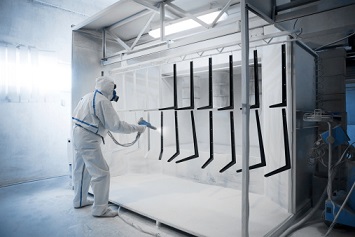A new EPA proposal states that existing emissions limits for hazardous air pollutants generated by three industry sectors engaged in coating operations are sufficient to protect people from cancer risks.

DingaLT / iStock / Getty Images Plus
Also, following a technology review, the Agency is proposing to require that operators in two of these sectors use high-efficiency spray equipment under certain circumstances. In addition, the EPA is soliciting public comments on several other potential new requirements affecting performance testing and the use of a work practice standard during malfunctions when it is not feasible to meet the emissions limits.
The proposal addresses three existing National Emissions Standards for Hazardous Air Pollutants (NESHAPs)—for surface coating of large appliances; for printing, coating, and dyeing of fabrics and other textiles; and for surface coating of metal furniture (the NESHAPs for these sectors were promulgated in 2002, 2003, and 2003, respectively).
Under the Clean Air Act, the EPA must conduct a residual risk review of existing NESHAPs to determine if they protect public health with an ample margin of safety and set more stringent standards if that margin is found not ample.
Furthermore, every 8 years after a NESHAP is promulgated, the Agency must conduct a review to determine if there have been new technological developments that may be appropriate to incorporate into the standards. Together these two reviews are called residual risk and technology reviews (RTRs).
Residual Risk Review
In the residual risk portion of the RTRs, the EPA starts with the premise that an individual lifetime cancer risk no higher than 100 in 1 million meets the ample-margin-of-safety criterion. Should the risk be found higher than that threshold, the Agency must determine if the risk can be lowered to an acceptable level through more stringent emissions limits. The current residual risk assessment found the following lifetime cancer risks:
- Large appliance category—0.9 in 1 million
- Fabric category—9 in 1 million
- Metal furniture category—7 in 1 million
Hence, the Agency concluded that in each case, the ample-margin-of-safety threshold is being met, and no adjustments to the existing emissions limits are needed.
Technology Review
Under its technological review, the EPA found that since promulgation of the original NESHAPs, sources in both the surface-coating-of-large-appliances and metal-furniture categories have widely adopted high-efficiency spray equipment. Accordingly, the Agency is proposing to require the use of high-efficiency sprayers for both categories. This requirement is proposed only for sources using spray application equipment without emissions capture (a permanent total enclosure) and a control device.
Comments Requested
The Agency is also requesting comments on the following:
- Whether the high-efficiency spray equipment technology requirement under the technology review is necessary in light of the risk analyses indicating that there are ample margins of safety.
- Whether performance testing should be required anytime a source plans to undertake an operational change that may adversely affect compliance with an applicable standard, operating limit, or parametric monitoring value. Any such requirement would include provisions to allow a source to make the change but limit the change to a specific time before a test is required. The EPA says it anticipates that a reasonable time limit under the new operations change would be approximately 30 days to allow adequate time for testing and developing a test report.
- Industry best practices and the best level of emissions control during malfunction events for the fabrics and other textiles source category.
As with other NESHAP and RTR revisions, the proposal would eliminate the start-up, shutdown, and malfunction exemptions and also require facilities to submit electronic copies of compliance reports, including performance tests.
Economic Impact
The EPA estimates the economic impact of the proposal changes as follows:
- For the 10 major sources subject to the large appliances NESHAP—$23,000
- For the 43 major sources subject to the fabrics and other textiles NESHAP—$90,000
- For the 16 major sources subject to the metal furniture—$32,000
The proposal was published in the September 12, 2018, Federal Register (FR).
